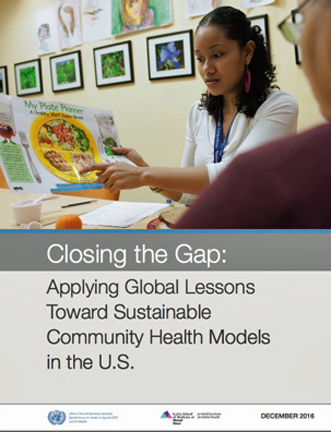Community health workers (CHWs), who are integral to healthcare in parts of the developing world, can also play a vital role in U.S. healthcare reform, according to a report released by the Arnhold Institute for Public Health at the Icahn School of Medicine at Mount Sinai and the Office of the U.N. Special Envoy for Health in Agenda 2030 and for Malaria. But they can only be effective if the programs receive institutional support and sustainable financing.
The report notes that “both the failure of high spending to produce improved outcomes and the disparities in health across communities point to the essential role of non-clinical social factors in shaping opportunities for healthy lives.” The proposed solution it outlines is a care model capable of bridging the gap between clinical and community settings. Experience around the world has shown that such a care model can be developed around CHWs, non-clinical health employees who do outreach and education in their communities.
CHW programs have existed in the United States for a several years but have struggled to demonstrate an impact on health and to achieve financial stability, according to the report. “Historically, community health worker programs have been grant-based or philanthropically supported,” Dr. Prabhjot Singh, director of the Arnhold Institute and lead author of the report told Crain’s Health Pulse. “[Funding goes] up and down and it doesn’t allow for investment in management and technology and long-term effectiveness.”
However, the potential for community health workers to improve health outcomes is gaining new attention under healthcare reform efforts including the Delivery System Reform Incentive Payment (DSRIP) program and the rise of patient-centered medical homes. Sergio Matos, executive director of the Community Health Worker Network of New York City, told Crain’s Health Pulse: “The future of healthcare is really more about paying attention to the social determinants of health and team-based care and prevention, and not so much the disease focus that has been our history.”
Each community health worker program must adapt to the needs of the particular population it’s serving. In doing so, it should adhere to best practices gathered from decades of experience around the world. The best practices highlighted by the report include finding both upfront capital and long-term revenue, which could come from making community health workers part of value-based contracts.
It also promotes strong ties between community health worker programs and a larger health system. “Even if the health system is not providing any or all of the funding for the CHW program, it must buy into the importance of integrating the CHW into [its] approach to patient care,” the report says. “Earning that buy-in from all levels of the health system—including C-suite, middle-management and frontline staff—is essential to building a sustainable program.”
Download a pdf of this story.
